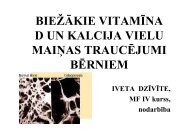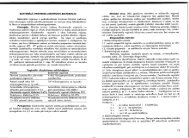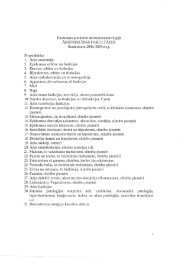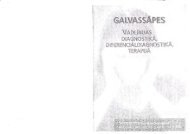PHYSICS
n - susliks.lv
n - susliks.lv
- No tags were found...
You also want an ePaper? Increase the reach of your titles
YUMPU automatically turns print PDFs into web optimized ePapers that Google loves.
flow of current, which in turn produces a force tending to oppose<br />
the movement of the conductor. Work will then have to be done<br />
to move the conductor:<br />
F.d,i =J( Lx jj) ·di. (18.8)<br />
The power input is P = dAjdt, and therefore<br />
P =J (L x jj). V, (18.9)<br />
where V is the velocity of the conductor. But the power input is<br />
given by P = JU, where U is the potential difference across the<br />
ends of the conductor; therefore<br />
- - -<br />
U = (L xB)·V. (18.10)<br />
When L, iJ, and V are mutually perpendicular, as in the<br />
case of the electromagnetic flow meter, the last equation<br />
simplifies to<br />
U = LBV. (18.11)<br />
This equation can be applied directly to measurement of the<br />
blood flow.<br />
Fig. 18.5. Electromagnetic flowmeter:<br />
1 - signal voltage; 2 <br />
electromagnet; 3 - readout<br />
system; 4 - blood vessel; S <br />
cross-sectional area of the vessel;<br />
V - velocity of the blood<br />
Fig. 18.6. Principles of threedimensional<br />
magnetocardiography<br />
through the mapping<br />
flow; U - potential difference;<br />
B - the magnetic field; / _<br />
of the magnetic field around<br />
distance between the poles<br />
the thorax of patient<br />
of magnet<br />
i f<br />
~.<br />
Chapter 19. BIOMAGNETISM<br />
19.1. MAGNETIC FIELDS IN LIVING ORGANISMS<br />
The word magnetography originates from Greek words magnetos<br />
meaning magnetic field and graphi meaning to write on. Neural<br />
tissue produces electrical potentials within the body and these<br />
potentials give rise to electrical currents in tissue. These currents<br />
will give rise to magnetic fields. Biomagnetic fields are produced<br />
also by the currents which circulate in biological membranes,<br />
blood vessels, around the heart (magnetocardiography), brain (magnetoencephalography),<br />
muscles (magnetomiography) , eye (magnetooculography).<br />
d5<br />
Magnetocardiography provide<br />
the mapping of the magnetic<br />
field around the thorax as a research<br />
tool. The magnetic field is<br />
a vector quantity and has therefore<br />
three components at each<br />
V location in space. The method of<br />
magnetocardiography is explained<br />
in fig. 18.6. Each of the three<br />
components are measured symmetrically<br />
(i.e., on both sides of<br />
the source). Such a system requires<br />
six magnetometers or six consecutive<br />
measurements with one<br />
magnetometer.<br />
The electromagnetic flow meter for blood flow measurement<br />
consists of an electromagnet to generate a magnetic field and two<br />
electrodes to sense the flow signal. They are encapsulated in an<br />
inert hard plastic in a form which permits them to fit around the<br />
blood vessel of interest (fig. 18.5). In this way the system can be<br />
used to measure the potential difference versus the blood flow.<br />
136<br />
Chapter 20. MAGNETIBIOLOGY<br />
• ... • M oQ'ii!'!S!' r<br />
20.1. MAGNETIC ORIENTATION IN ANIMALS<br />
The total intensity of the geomagnetic field is highest near the<br />
magnetic poles, with more than 60000 nT; it decreases to values<br />
of about 26000 nT at the magnetic equator. The magnetic orientation<br />
means that animals use information from the magnetic field<br />
to direct and control their behavior.<br />
137






